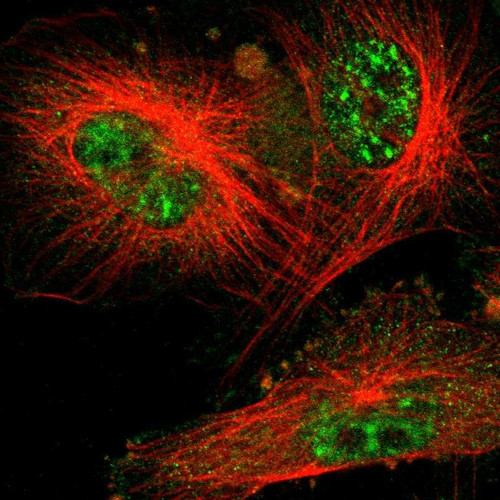Anti CDC34 pAb (ATL-HPA002382)
Atlas Antibodies
- Catalog No.:
- ATL-HPA002382-25
- Shipping:
- Calculated at Checkout
$395.00
Gene Name: CDC34
Alternative Gene Name: E2-CDC34, UBC3, UBE2R1
Isotype: IgG
Interspecies mouse/rat: ENSMUSG00000020307: 98%, ENSRNOG00000060530: 98%
Entrez Gene ID: 997
Uniprot ID: P49427
Buffer: 40% glycerol and PBS (pH 7.2). 0.02% sodium azide is added as preservative.
Storage Temperature: Store at +4°C for short term storage. Long time storage is recommended at -20°C.
| Product Specifications | |
| Application | WB, ICC, IHC |
| Reactivity | Human |
| Clonality | Polyclonal |
| Host | Rabbit |
| Immunogen | LNEPNTFSPANVDASVMYRKWKESKGKDREYTDIIRKQVLGTKVDAERDGVKVPTTLAEYCVKTKAPAPDEGSDLFYDDYYEDGEVEEEADSCFGDDEDDSGT |
| Gene Sequence | LNEPNTFSPANVDASVMYRKWKESKGKDREYTDIIRKQVLGTKVDAERDGVKVPTTLAEYCVKTKAPAPDEGSDLFYDDYYEDGEVEEEADSCFGDDEDDSGT |
| Gene ID - Mouse | ENSMUSG00000020307 |
| Gene ID - Rat | ENSRNOG00000060530 |
| Buffer | 40% glycerol and PBS (pH 7.2). 0.02% sodium azide is added as preservative. |
| Documents & Links for Anti CDC34 pAb (ATL-HPA002382) | |
| Datasheet | Anti CDC34 pAb (ATL-HPA002382) Datasheet (External Link) |
| Vendor Page | Anti CDC34 pAb (ATL-HPA002382) at Atlas Antibodies |
| Documents & Links for Anti CDC34 pAb (ATL-HPA002382) | |
| Datasheet | Anti CDC34 pAb (ATL-HPA002382) Datasheet (External Link) |
| Vendor Page | Anti CDC34 pAb (ATL-HPA002382) |
| Citations for Anti CDC34 pAb (ATL-HPA002382) – 1 Found |
| Takagi, Keiko; Takayama, Tadatoshi; Midorikawa, Yutaka; Hasegawa, Hiromasa; Ochiai, Takanaga; Moriguchi, Masamichi; Higaki, Tokio; Soma, Masayoshi; Nagase, Hiroki; Fujiwara, Kyoko. Cell division cycle 34 is highly expressed in hepatitis C virus-positive hepatocellular carcinoma with favorable phenotypes. Biomedical Reports. 2017;7(1):41-46. PubMed |




![Lane 1: Marker [kDa] 230, 130, 95, 72, 56, 36, 28, 17, 11<br/>Lane 2: Human cell line RT-4 Lane 1: Marker [kDa] 230, 130, 95, 72, 56, 36, 28, 17, 11<br/>Lane 2: Human cell line RT-4](https://cdn11.bigcommerce.com/s-ydswqc5qsc/images/stencil/500x659/products/80757/146812/atl-hpa002382_anti-cdc34-pab-atl-hpa002382_28435__43224.1681095597.jpg?c=2)